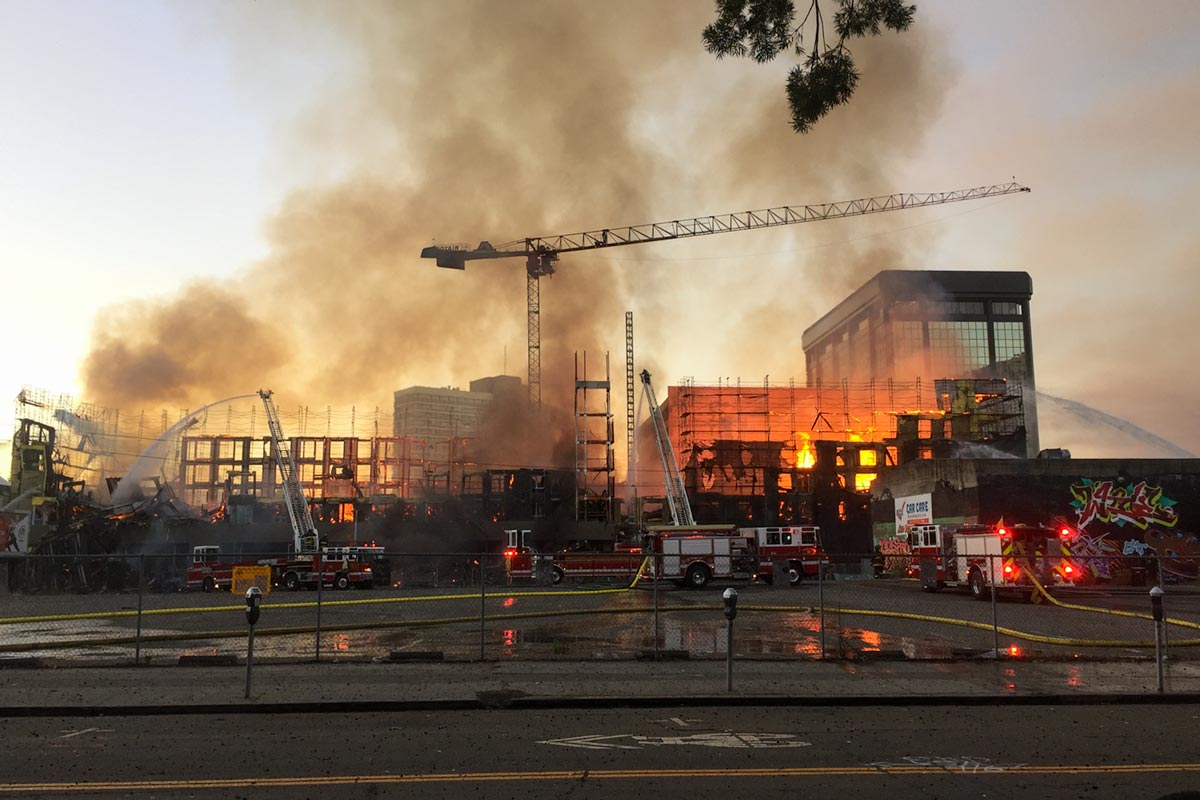“The CCIM designation and its symbolic Pin changed my life.” This is how I planned on opening a recent talk I gave in which I was asked to share a little bit about my practice and the CCIM designation. But being just a couple of weeks away from July 7, a significant anniversary in my career, I decided to draw this conclusion out with a story. Show, not tell.
On July 7, 2017 I was awakened by a call from one of my uncles.
“The building is on fire!” he half-shouted over the phone. “You should get down here.”
“Which building?” I replied, popping out of bed. “How bad?”
He was silent. For a while.
“This is bad, Tony. Real, real bad. It’s the project next to us. The whole thing is burning.”
I got it immediately. I threw on a pair of jeans and my True Burger t-shirt, remembering that recently a few buildings had burned down during construction. Most people suspected arson.
I told my wife I would be working late, hopped in the car, and headed for the Caldecott Tunnel.
An empty freeway gave me time to think, and my mind began enumerating the tasks and projects I would have to set aside.
I was in the middle of analyzing a PSA from a developer for an assemblage of land, and tying the offered land price to the residual land value calculated in the proforma. Did it make sense? Was it a fair price? Why was the yield on cost as high as it was? How could we influence that metric, since that seemed to be the focus point for the developer’s committee?
My mind hopped to the scenario study that followed on the sale opportunity. We were going to present our transaction strategy at the family meeting, and the study was necessary for the decision-making process. Should we 1031 when we sold? Or, should we pay tax and distribute cash? Should we—could we—delay the transaction, do a drop-and-swap, and season the change in ownership so everyone could go their separate ways in either direction?
And then there are the buyouts, I thought to myself as I merged onto Highway 24. In order for us to build more housing we needed to relocate people. I was able to hold heart-to-heart conversations with most of our tenants, and had good relationships with them, so my family leaned on me to create the opportunities. A firm believer in the principles of “both-and” and “win-win” negotiations, I was succeeding in finding paths forward to unlock value for us and for the tenants.
I entered the Caldecott Tunnel. The thought of win-win pushed my mind over to my commercial real estate studies, and my pursuit of the CCIM designation. I would be testing in Toronto in October for the designation and its emblematic lapel pin. My portfolio of qualifying experience was completed and approved. Did I have my passport?
I popped out of the Caldecott and my mind stopped. As I made my way down the hill, I could make out a pillar of smoke down by Lake Merritt. The thought of the Israelites being led in the desert crossed my mind, and I started praying.
By the end of that day, and by that I mean somewhere around 11:30 pm, I had firmly resolved that I would advocate for the CCIM education, networking, and designation for the rest of my life.
I pulled up to the office and could see the massive fire ringed by metal scaffolding, unquenched by the streams of water pouring from fire engines. Overhead the red crane slowly spun, moved by the rising heat. Ash and bits of charred lumber was falling from the sky.
I ran up the street, crunching charcoal, wondering how I could help.
I was met by a firefighter halfway up the street. I could barely hear him over the roar of the fire and the clamor of the firefighting effort. He told me that everyone in a two-block radius was evacuated because of the crane. Its foundation was compromised by the heat of the fire, and it could fall at any time. This meant it could fall on our buildings.
I told him that I had more than eighty households I was going to account for. He let me through to find my people.

Throughout the day I leaned heavily on the negotiation principles I picked up from the Commercial Real Estate Negotiations course of the CCIM. I met several stakeholders throughout the day and made a point to track their interests and as we negotiated money and time, and agendas.
Most tenants had found somewhere to stay by the late afternoon. Red Cross volunteers and leadership were working with me on identifying, and housing, displaced tenants that could not lean on friends. Oakland Fire and Police were checking in to discuss housing, entry into units, risks posed by the crane, and new risks caused by falling glass from one of the high rises. City of Oakland Emergency Management team members worked with me and the tenants to offer city services. The Assistant to the Mayor joined them, helping however he could.
The CCIM negotiations course trained me to stay focused on the interests of the parties, and to align those interests across multiple parties. I was bolstered by the confidence that I knew how to be mindful of those interests and my own, and influence or mobilize organizational representatives to address the principal interest we shared, namely, housing our tenants.
While in a status meeting led by the Oakland fire captain, I received a text that critical updates to an analysis were needed. I stepped out for a few minutes and grabbed a chair in the lobby.
Thanks to the CCIM core courses, I built these models myself, and didn’t need to lean on expensive third-party software to do scenario analysis. I read the email with the requested changes and made them to my discounted cash flow model on the fly.
Sometimes changes on the fly are easy. For example, modifying the anticipated sale price and in turn reflecting the change in anticipated tax on gain, which in turn impacted the cash reserve for the limited partnership, and partner distribution amounts was easy.
Sometimes changes to scenario models are not. For example, how does a family enterprise plan around a loan from one holding company to another, serviced at Applicable Federal Rates, while still staying within operating budgets for the general partner entity and holding companies? Or, assuming an unequal allocation of LP interests in a real estate holding company when funding resulting truss following the first spouse’s death, what class of commercial real estate is the best for the holding company to exchange into?
I hit Send, then stepped back into the meeting, grateful for the CCIM education and training, and power to build strong connections and relationships that the local CCIM Chapter taught me to harness.

